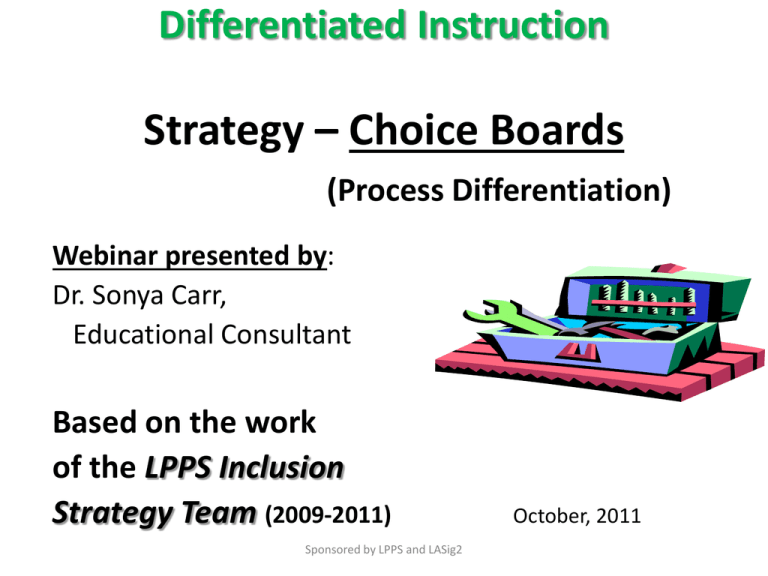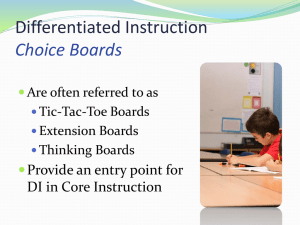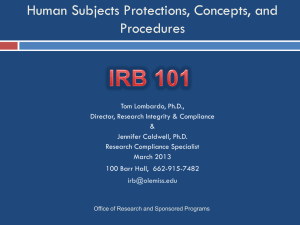View Power Point
advertisement

Differentiated Instruction Strategy – Choice Boards (Process Differentiation) Webinar presented by: Dr. Sonya Carr, Educational Consultant Based on the work of the LPPS Inclusion Strategy Team (2009-2011) Sponsored by LPPS and LASig2 October, 2011 Choice Boards • In a differentiated • Framework : Activities may be organized using classroom, choice boards can be built into o Bloom’s Taxonomy the curriculum to appeal o Multiple Intelligences to learners and to meet o Modality Preferences individual needs. o Students Interests • Board Options: • Choice boards offer o Think-Tac-Toe multiple ways for students to process o Bingo information and practice o Choice wheels content and skills. – Focus on use for process differentiation Sponsored by LPPS and LASig2 Sample Choice Boards BINGO Goal: Get one signature per square Caution: Don’t sign more than three times on any person’s grid. Sponsored by LPPS and LASig2 Least favorite subject English Likes to read romance novels Likes to read mysteries Favorite subject is math Least favorite subject Science Free time – watches movies at home Free time watches TV at home Collects Beanie Babies Would like to meet Michael Jordan Would like to have met Dr. Martin Luther King Hobby – playing with dog Hobby – reading Hobby – playing tennis Free time lounges in bath at home Collects teddy bears Collects pictures Collects paper weights Would like to meet Wally Amos Collects junk Would like to meet Oprah Winfrey Enjoys talking with husband Would like to have met Abraham Lincoln Would like to have met Dr. Frederick Douglas Would like to have met Marie Clay Would like to have met David (Bible) EXAMPLE OF THE FLOW OF LESSONS IN A DIFFERENTIATED UNIT (below) 1 3 5 7 Whole Class: Whole Class: Whole Class: Exploration of a topic or concept Share information and pose questions Review key ideas and extend study through sharing In small readiness groups assigned by the teacher , students engage in Cubing or ThinkDOTS activities . 2 Students work independently on Think- Tac-Toe completing 9-10 Whole Class: Introduce skills needed later to make a presentation Students chose groups based on interests and solve problems related to the unit tiered assignments designed to help them make sense of key concepts at varied levels of complexity and varied 4Sponsored by LPPS and LASig26 pacing Whole Class: Individual students present projects for summative assessment Students independently complete a learning menu through which they will apply and extend their understandings 8 When designing a choice board, the teacher …. 1. Examines a unit in the curriculum, looking at the standards, benchmarks, GLEs to determine important content (focus for DI) 2. Decides on a framework for the choice board (e.g., Bloom’s Taxonomy, Multiple Intelligences, Modality Preferences, student interests) 3. Brainstorms and writes activities that are aligned with the instructional goal(s), standards, and framework selected (nine activities for Tic-Tac-Toe, 20-25 activities for Bingo). 4. Arranges the activities on a blank Tic-Tac-Toe or Bingo template. 5. Reviews the order of the activities and arranges, or re-arranges, the activities so that all students have some challenge. 6. Shares the draft Choice Board with a colleague, requests feedback, and revises board activities. 7. Develops scoring criteria for each activity. 8. Decides on a time frame and procedures for monitoring activities as they are completed. Sponsored by LPPS and LASig2 When designing a Think-Tac-Toe Board, use this guide: Easier activity or something presented at the beginning of unit More challenging Easier activity or something presented at the beginning of unit More challenging Easier activity or something presented at the beginning of unit More challenging More challenging More challenging Easier activity or something presented at the beginning of unit Sponsored by LPPS and LASig2 Framework Using Bloom’s Taxonomy: Knowledge Comprehension Application Analysis Synthesis Evaluation Comprehension or Evaluation Application or Evaluation Knowledge or Analysis Sponsored by LPPS and LASig2 Sponsored by LPPS and LASig2 Think-Tac-Toe Directions: Choose activities in a tic-tac-toe design. When you have completed the activities in a row-horizontally, vertically, or diagonally – you may decide to be finished, or you may decide to keep going and complete more activities. I choose activities # __________, # __________, # __________. Name: __________________________Date Received: ____________ Date Due: _______________________Date Completed: ___________ Sponsored by LPPS and LASig2 Sponsored by LPPS and LASig2 Sponsored by LPPS and LASig2 Writing Bingo Try for one or more BINGOs this month. Remember, you must have a real reason for the writing experience! If you mail or email your product, get me to read it first and initial your box! Be sure to use your writing goals and our class rubric to guide your work. (J. Melin) Recipe Thank you note Letter to the editor Directions to one place to another Rules for a game Invitation Email request for information Letter to a pen pal, friend, or relative Skit or scene Interview Newspaper article Short story FREE Your choice Grocery or shopping list Schedule for your work Advertisement Cartoon strip Poem Instructions Greeting card Letter to your teacher Journal for a week Design for a web page Book Think Aloud B Proposal to improve something I N Sponsored by LPPS and LASig2 G O For more information, visit LPPS Moodle or contact: Ms. Felicia Boyd, LPPS Special Education Teacher FELICIA.BOYD@lpsb.org Ms. Anita Clark, LPPS General Education Teacher ANITA.CLARK@lpsb.org Ms. Demarious Poole, Inclusion/Staff Development Coordinator, DEMARIOUS.POOLE@lpsb.org Dr. Sonya Carr, Educational Consultant SonyaC.Carr@gmail.com Sponsored by LPPS and LASig2








